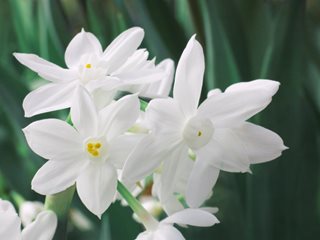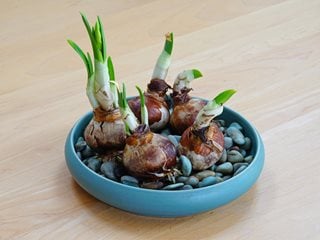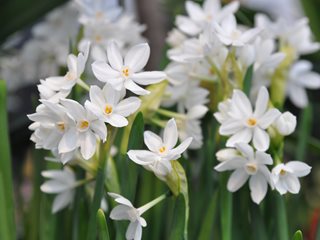A Guide to Growing Paperwhite Flowers
Break out of the winter doldrums with these easy-to-grow flowering bulbs. Get tips for forcing indoors, planting in the garden, and buying the best bulbs.If you long for spring daffodils during the bleak days of winter, paperwhites are a close relative that you can force indoors at almost any time of year to make it feel like spring even on a snowy day. Like amaryllis
On this page: Basics | Forcing Indoors | Growing Outdoors | Care | Bulb Buying Tips
On this page:
- BASICS
- FORCING PAPERWHITES INDOORS
- GROWING PAPERWHITES OUTDOORS
- PAPERWHITES CARE
- PAPERWHITE BULB BUYING TIPS
BASICS
Botanical name:
Narcissus papyraceus
Plant type & origin:
Perennial bulb, native to the Mediterranean.
Zones:
8 to 11
Bloom time:
Typically 4 to 8 weeks after planting indoors. February to March when planted outdoors.
Height:
12 to 18 inches
Flower colors:
Usually pure white flowers, but you’ll also find cultivars with yellow, orange, and bi-colored blooms.
Bloom size:
2 to 3 inches across
Special features:
Fragrant, fast growing, disease and pest resistant
Precautions:
All parts of the plant can be toxic if ingested, especially the bulb. If growing indoors, keep away from children and pets.
FORCING PAPERWHITES INDOORS
You can plant your paperwhites in potting soil or in shallow containers of water with some pebbles or decorative stones added to keep them in place. Note that some paperwhite varieties will force better in soil than in water alone, so be sure to read the guidelines on the bulb package before planting.
Growing paperwhites in soil:
Find a shallow pot (about 4 to 5 inches deep) with holes in the bottom for drainage. Fill until about three-quarters full with an indoor potting mix and plant the bulbs with the pointed ends facing up, allowing the tips to peek above the soil. Water well, allowing the water to drain through the holes.
Growing paperwhites in water and pebbles:
For this method, use a container without drainage holes so it can hold water. Fill it about halfway with your choice of pebbles, marbles, decorative stones, or glass beads and set the bulbs on top. Pack more pebbles around the bulbs to hold them in place, leaving the pointed tips exposed, and then add water to a level no higher than the base of the bulbs. Add more water as needed to maintain this level as the plants take root and grow.
Container options:
There’s no need to buy a special container for growing paperwhites because a simple decorative saucer or bowl will work fine and provide enough growing room for the roots. You can also grow paperwhites in a tall glass vase, which will help keep your plants upright as they grow and allow you to watch the bulbs take root.
Just be sure to choose a container large enough to accommodate the number of bulbs you plan to plant. For a fuller display, plant multiple bulbs in one container, spacing them no more than an inch apart.
GROWING PAPERWHITES OUTDOORS
In warm climates (zones 8 to 11), paperwhites are a great alternative to daffodils, jonquils, and other members of the Narcissus genus that require a period of cold weather in order to bloom outdoors.
Plant the bulbs anytime in the fall or early winter for blooms the following spring. Choose a sunny spot with well-drained soil, and plant the bulbs in holes about 6 inches deep, spacing them several inches apart. For maximum impact, plant in groups of 10 or more.
Get more tips for planting bulbs in the garden.
PAPERWHITE CARE
Watering:
If your paperwhites are planted in a container with stones or pebbles, keep the water level just under the bulb base. If they are planted in soil, water only when the soil is dry to the touch. Avoid overwatering, which can cause the bulbs to rot and prevent blooming.
Light/temperature:
To extend the bloom time of your paperwhites, keep them in a cool location (about 65 degrees F) and away from direct sunlight. Too much light will cause the flowers to wither faster and too little may cause the stems to get leggy. A spot with bright, indirect light is best.
Provide support:
Indoors, you may need to prop up your paperwhites with small stakes or encircle them with ribbon, twine, or a support ring to prevent the slender stems from collapsing under the weight of the flowers.
Stunting paperwhite growth:
Another solution to keep them from flopping is to stunt the growth of your plants so they don’t get tall and lanky by “pickling” them in gin or another distilled spirit, according to research from Cornell University. Spiking the growing water with alcohol will reduce the height of the stems by as much as 50% without affecting the size of the flowers. Learn how its done.
After they bloom:
Paperwhite blooms usually last about two to three weeks after they open. Once all the flowers have faded, the foliage will still be worthy of display for a few more weeks. Although it’s possible to get your bulbs to bloom again indoors, it’s usually not worth the fuss and most people find it easier to discard or compost the bulbs and buy new ones.
Outdoors in the garden, treat paperwhites as you would daffodils. Cut off the spent flowers but leave the foliage in place until it begins to turn yellow and you can pull it out by hand.
PAPERWHITE BULB BUYING TIPS
A few things to keep in mind when shopping for paperwhites:
- Buy the largest paperwhite bulbs you can find, because the bigger the bulb, the more flower stalks and blooms it will produce. Look for bulbs with a circumference of at least 17 centimeters (usually labeled as 17+ cm).
- If you are purchasing bulbs from a local garden center, make sure the bulbs are firm, like an onion, and free of soft spots and discoloration. Avoid any that feel squishy or have dark mold spots on the surface, which could be signs of rot.
- Paperwhites are the most fragrant members of the daffodil family, but some varieties (such as ‘Ziva’) have a strong, musky scent that some people find overpowering. If you prefer a lighter scent, try cultivars with just a hint of fragrance, such as ‘Inbal’ or ‘Wintersun’.
- For the best selection, shop for your paperwhite bulbs at garden centers or online beginning in late September, when the supply is most plentiful. By midwinter, the bulbs will be harder to come by. If you want blooms all winter, buy enough bulbs so you can plant them at intervals and stagger the bloom times.
- After buying your bulbs, store them in a cool place (about 55 to 60 degrees F) to preserve their quality until you plant them. Paperwhite bulbs have a short shelf life, so try to get them in pots within two to three months.





